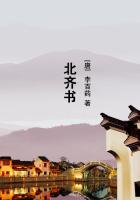The great redwoods, too, add to the colored-edition impression of the whole country.A redwood, as perhaps you know, is a tremendous big tree sometimes as big as twenty feet in diameter.It is exquisitely proportioned like a fluted column of noble height.Its bark is slightly furrowed longitudinally, and of a peculiar elastic appearance that lends it an almost perfect illusion of breathing animal life.The color is a rich umber red.Sometimes in the early morning or the late afternoon, when all the rest of the forest is cast in shadow, these massive trunks will glow as though incandescent.The Trail, wonderful always, here seems to pass through the outer portals of the great flaming regions where dwell the risings and fallings of days.
As you follow the Trail up, you will enter also the permanent dwelling-places of the seasons.With us each visits for the space of a few months, then steals away to give place to the next.Whither they go you have not known until you have traveled the high mountains.Summer lives in the valley; that you know.Then a little higher you are in the spring-time, even in August.Melting patches of snow linger under the heavy firs; the earth is soggy with half-absorbed snow-water, trickling with exotic little rills that do not belong; grasses of the year before float like drowned hair in pellucid pools with an air of permanence, except for the one fact; fresh green things are sprouting bravely; through bare branches trickles a shower of bursting buds, larger at the top, as though the Sower had in passing scattered them from above.Birds of extraordinary cheerfulness sing merrily to new and doubtful flowers.The air tastes cold, but the sun is warm.The great spring humming and promise is in the air.And a few thousand feet higher you wallow over the surface of drifts while a winter wind searches your bones.I used to think that Santa Claus dwelt at the North Pole.
Now I am convinced that he has a workshop somewhere among the great mountains where dwell the Seasons, and that his reindeer paw for grazing in the alpine meadows below the highest peaks.
Here the birds migrate up and down instead of south and north.It must be a great saving of trouble to them, and undoubtedly those who have discovered it maintain toward the unenlightened the same delighted and fraternal secrecy with which you and Iguard the knowledge of a good trout-stream.When you can migrate adequately in a single day, why spend a month at it?
Also do I remember certain spruce woods with openings where the sun shone through.The shadows were very black, the sunlight very white.As I looked back I could see the pack-horses alternately suffer eclipse and illumination in a strange flickering manner good to behold.The dust of the trail eddied and billowed lazily in the sun, each mote flashing as though with life; then abruptly as it crossed the sharp line of shade it disappeared.
From these spruce woods, level as a floor, we came out on the rounded shoulder of a mountain to find ourselves nearly nine thousand feet above the sea.
Below us was a deep canon to the middle of the earth.And spread in a semicircle about the curve of our mountain a most magnificent panoramic view.
First there were the plains, represented by a brown haze of heat; then, very remote, the foot-hills, the brush-hills, the pine mountains, the upper timber, the tremendous granite peaks, and finally the barrier of the main crest with its glittering snow.From the plains to that crest was over seventy miles.I should not dare say how far we could see down the length of the range; nor even how distant was the other wall of the canon over which we rode.Certainly it was many miles; and to reach the latter point consumed three days.
It is useless to multiply instances.The principle is well enough established by these.Whatever impression of your trail you carry away will come from the little common occurrences of every day.That is true of all trails; and equally so, it seems to me, of our Trail of Life sketched at the beginning of this essay.
But the trail of the mountains means more than wonder; it means hard work.Unless you stick to the beaten path, where the freighters have lost so many mules that they have finally decided to fix things up a bit, you are due for lots of trouble.Bad places will come to be a nightmare with you and a topic of conversation with whomever you may meet.
We once enjoyed the company of a prospector three days while he made up his mind to tackle a certain bit of trail we had just descended.Our accounts did not encourage him.Every morning he used to squint up at the cliff which rose some four thousand feet above us."Boys," he said finally as he started, "Imay drop in on you later in the morning." I am happy to say he did not.
The most discouraging to the tenderfoot, but in reality the safest of all bad trails, is the one that skirts a precipice.Your horse possesses a laudable desire to spare your inside leg unnecessary abrasion, so he walks on the extreme outer edge.If you watch the performance of the animal ahead, you will observe that every few moments his outer hind hoof slips off that edge, knocking little stones down into the abyss.
Then you conclude that sundry slight jars you have been experiencing are from the same cause.Your peace of mind deserts you.You stare straight ahead, sit VERY light indeed, and perhaps turn the least bit sick.The horse, however, does not mind, nor will you, after a little.There is absolutely nothing to do but to sit steady and give your animal his head.In a fairly extended experience I never got off the edge but once.Then somebody shot a gun immediately ahead; my horse tried to turn around, slipped, and slid backwards until he overhung the chasm.
Fortunately his hind feet caught a tiny bush.He gave a mighty heave, and regained the trail.Afterwards I took a look and found that there were no more bushes for a hundred feet either way.















